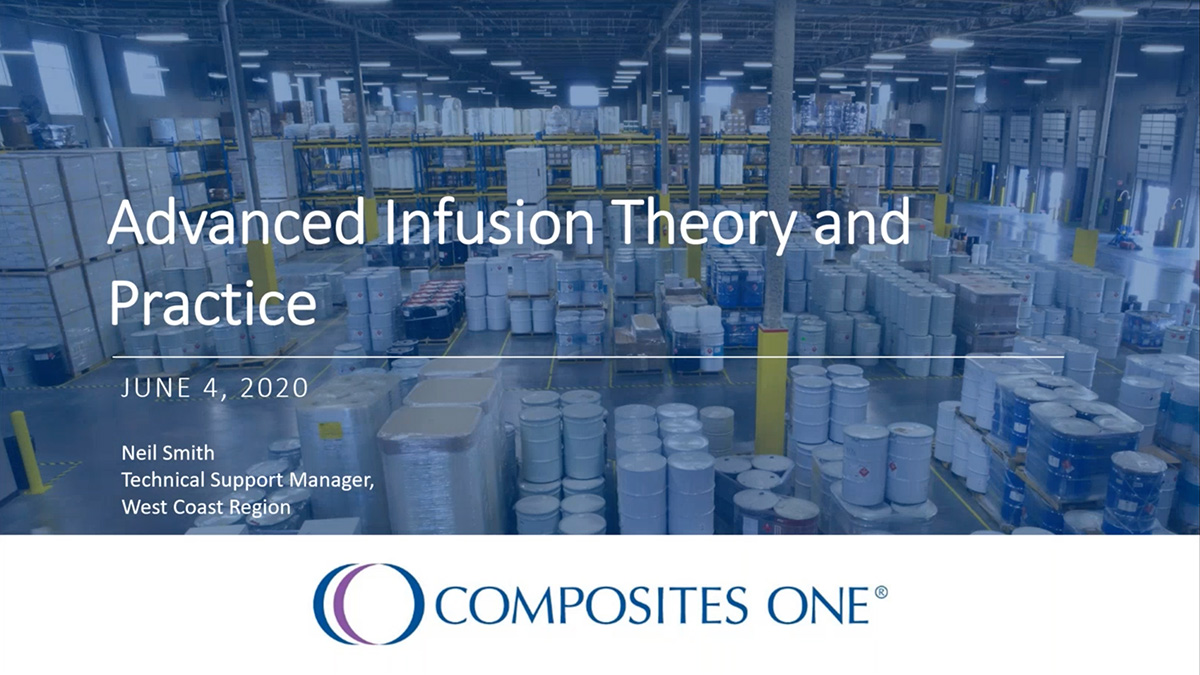News
Composites One Offers Valuable Expertise in Vacuum Infusion Processing
When it comes to infusion processing and the various types of infusion layups, it is important to have a composites manufacturing expert who can help apply the proper manufacturing techniques based on the desired outcome and composite application. With technical support from Composites One, customers can make an informed decision on every part of the process, from material selection to the best manufacturing techniques suited for the application.
In infusion processes like vacuum infusion and resin injection, our technical support experts have a thorough and expert understanding of the principles of D’Arcy’s law, which govern the highly controllable infusion process.
According to D’arcy’s law, the flow rate of resin is dictated by three critical variables:
- Permeability of reinforcements/layup material
- Pressure gradient, or differential in the cavity in relation to atmospheric pressure, and
- Viscosity of the resin
When all three of these variables are unchanged, the infusion process will flow consistently with each injection for a given part. This provides consistency for planning and budgeting for the resin and reinforcement materials used in the process.
Permeability of reinforcements/layup material
With the variation of flow setups, the cross-sectional area of the laminate can change dramatically based on the flow setup, with flow times varying based on the position of the flow front:
- Circumferential injection – the cross-sectional area decreases proportionately with distance from the injection point. Light Resin Transfer Molding (LRTM) follows a circumferential injection process and offers the fastest flow setup.
- Strip injection – the cross-sectional area remains constant and therefore area affects do not have any net effect on flow speed.
- Point injection – the cross-sectional area increases linearly with distance from the injection point. With point injection, flow times are significantly slower. A typical silicone bag setup follows a point injection setup.
With resin infusion, resin starts with only the central feeder open, and the infused resin continues to permeate the dry laminate by opening additional feeds after resin passes new feed points. Sequential feed setup enables the infusion process for an unlimited-sized part. For larger-scale infusions, customers can request support from their local Composites One technical support manager as a resource for selecting the type of infusion layup to achieve optimum resin flow.
Accounting for pressure gradients
Pressure differential and gradient is influential in optimizing the infusion process. Your technical support manager can help you understand the importance of absolute vs. relative pressure as it relates to infusion processing. Conventional vacuum gauges do not account for the weight of the atmosphere. This is referred to as relative pressure. Absolute pressure accounts for total pressure, a concept that is necessary to understand when it comes to pressure differential.
Infusion speeds significantly drop off relative to the distance from the injection point. During infusion process, resin is at atmospheric pressure. After the bag has been fully drawn down, the entire weight of the atmosphere is now supported on the reinforcement, with fully consolidated fiber.
Infusion is not yet finished when the mold cavity is filled. By altering the vacuum pressure and appropriately closing off inlet and outlets, it is possible to minimize thickness variations and pressure gradients across the laminate. Often the most desirable option to achieve this is by closing off the resin inlet and increasing absolute pressure at the vacuum outlet, i.e., decreasing the vacuum. After you close off the resin line and decrease the vacuum, you will see measurable differences in thickness from the resin inlet location to the vacuum locations. Also, elevating the height of the resin supply has a relative effect on the pressure gradient differential.
Understanding high-temperature processing resins
Viscosity is dependent on temperature and resin chemistry. Reins that start in solid form and need to be heated before reaching appropriate viscosity values to infuse are known as high-temperature processing resins. This type of advanced composites processing is often used in Aerospace and Wind Energy applications. Examples include:
- Polymide resins – Typically used at service temperatures around 700 degrees Fahrenheit, these are used for resin film infusion.
- Bismaleimide (BMI) resins – Typically used at service temperatures around 400 degrees Fahrenheit, and with excellent hot and wet properties, these are commonly used in tooling prepreg resins.
Composites One’s technical support team can guide customers with proper setup and layup in high-temperature, vacuum-assisted processes, and help with material selection for the various consumables and accessories that are used in high-temp processing. These materials include:
- Vacuum/resin tubing
- Resin line inlet
- Infusion media
- Vacuum connectors and fittings
- Sealant tape
Resin infusion in Aerospace
Resin infusion is often used in Aerospace applications, offering significant cost savings, close to unlimited part sizes, unlimited open times for materials, and reduced investment, space, and cycle times associated with large autoclaves. Boeing patented a production process known as Controlled Atmospheric Pressure Resin Infusion Process (CAPRI) that is currently in production and uses the variables from Darcy’s law. The abstract reads:
“By evacuating the resin feed tank to a pressure below atmospheric pressure, employing cyclic compaction, and controlling the net compaction pressure, we are better able to control a resin infusion process, particularly a vacuum-assisted resin transfer molding process, and produce aerospace-grade fiber reinforced resin composites having fiber volume fractions and tool-side surface finish comparable to or exceeding those made using an autoclave.”
Manufacturers are not expected to be experts in advanced infusion theory and practice. The technical experts at Composites One are always available to guide manufacturers on proper infusion techniques and any composites manufacturing process that is right for their manufacturing requirements and applications.
Watch the full webinar to learn more: Advanced Infusion Theory and Practice.


